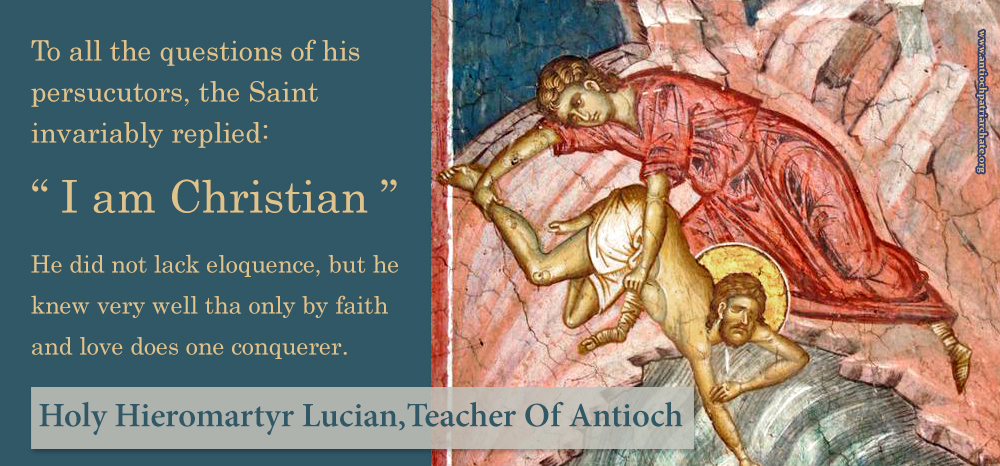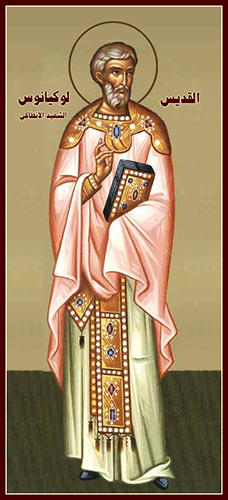
Saint Lucian the Martyr of Antioch
"The Hieromartyr Lucian, Presbyter of Antioch, was born in the Syrian city of Samosata. At twelve years of age he was left orphaned. Lucian distributed his possessions to the poor, and went to the city of Edessa to the confessor Macarius, under the guidance of whom he diligently read Holy Scripture and learned the ascetic life. For his pious and zealous spreading of Christianity among the Jews and pagans, Lucian was made a presbyter.
he was left orphaned. Lucian distributed his possessions to the poor, and went to the city of Edessa to the confessor Macarius, under the guidance of whom he diligently read Holy Scripture and learned the ascetic life. For his pious and zealous spreading of Christianity among the Jews and pagans, Lucian was made a presbyter.
In Antioch St Lucian opened a school where many students gathered. He taught them how to understand the Holy Scriptures, and how to live a virtuous life. St Lucian occupied himself with teaching, and he corrected the Greek text of the Septuagint, which had been corrupted in many places by copyists and by heretics who deliberately distorted it in order to support their false teachings. The entire Greek text of the Bible which he corrected was hidden in a wall at the time of his confession of Christ, and it was found during the lifetime of St Constantine the Great.
During the persecution of Diocletian, St Lucian was arrested and was sent to prison in Nicomedia, where for nine years he encouraged other Christians with him to remain steadfast in their confession of Christ, urging them not to fear tortures or death.
["The persecution was horrible and not even young children were spared. Two boys who did not want to eat food sacrificed to idols were thrown into a boiling bath, where in torments they gave up their holy souls to God. A disciple of Lucian named Pelagia (October 8) preserved her virginal purity from dissolute attackers by praying to God on her roof-top: she gave up her soul to Him, and her body fell from the roof...
St. John Chrysostom writes of St. Lucian: ``He scorned hunger: let us also scorn luxury and destroy the power of the stomach that we may, when the time that requires such courage comes for us, be prepared in advance by the help of a lesser ascesis, to show ourselves glorious at the time of battle.
St Lucian died in prison from many terrible tortures and from hunger. Before his death, he wished to partake of the Holy Mysteries of Christ on the Feast of Theophany. Certain Christians who visited him brought bread and wine for the Eucharist. The hieromartyr, bound by chains and lying on a bed of sharp potsherds, was compelled to offer the Bloodless Sacrifice upon his chest, and all the Christians there in prison received Communion.(***See below for more details) The next day the emperor sent people to see if the saint was still alive. St Lucian said three times, "I am a Christian," then surrendered his soul to God. The body of the holy martyr was thrown into the sea, but after thirty days dolphins brought it to shore. Believers reverently buried the body of the much-suffering St Lucian.
St Lucian was originally commemorated on January 7, the day of his death. Later, when the celebration of the Synaxis of St John the Baptist was appointed for this day, the feast of St Lucian was transferred to October 15. The October date may be associated with the dedication of a church which was built in Antioch by St Helen (May 21) over St Lucian's holy relics.
Although he was only a priest, sometimes St Lucian is depicted in the vestments of a bishop. The Stroganov Guide for Iconographers was published in Russia in 1869, based on a 1606 manuscript. There St Lucian is depicted wearing a phelonion and holding a Gospel. He does not wear the omophorion of a bishop, however. Another handbook, the Litsevoy Podlinnik, states that St Lucian is to be depicted with the omophorion.
It may be that the Russians thought of St Lucian as a bishop because of his importance to the Church, and so that is how they depicted him. Similarly, St Charalampus (February 10) is depicted as a priest in Greek icons, and as a bishop in Russian icons."

2025-12-01
Address of Patriarch JOHN X The…
2025-11-24
Delegation from the Hungarian…
2025-11-22
The Antioch Patriarchate Index…
2025-11-21
His Beatitude John X, Meets…
2025-11-19







